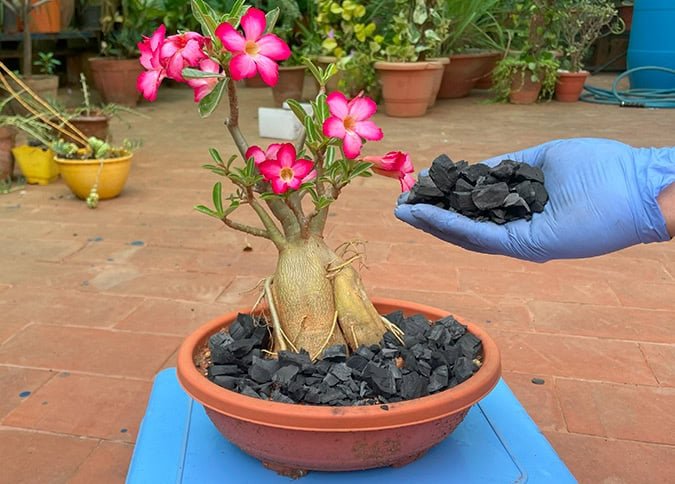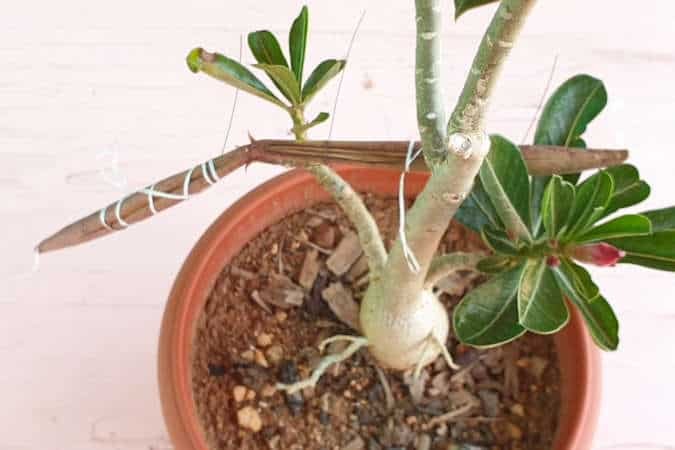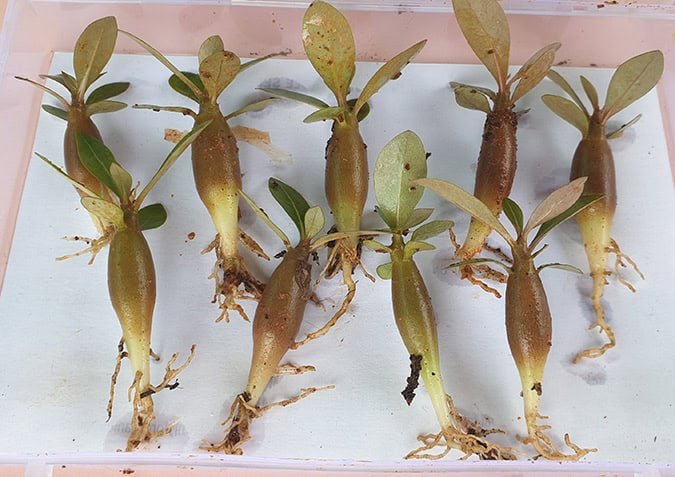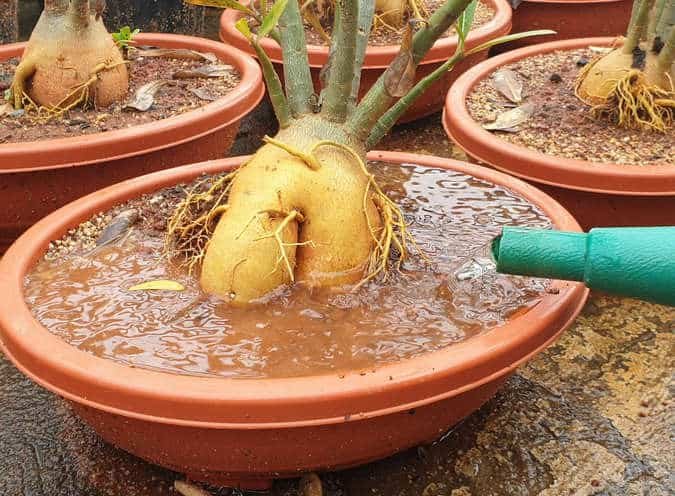Contents
Today’s post is a complete guide on growing Adenium or the Desert Rose plant, including Important Topics like its General Care tips, Nursery secrets of Growing Adeniums from Seeds, How to get the seeds, 5 Tricks to make the caudex grow thicker, How to save a dying Adenium or dealing with adenium rot, and lot more.

Adenium Obesum: An Overview
Adenium obesum, commonly known as the desert rose, is a captivating succulent plant celebrated for its vibrant blooms ranging in red, pink, white, and other captivating shades.
This extraordinary plant is often referred to as a natural bonsai due to its thick, sculptural stems and distinctive caudex—a swollen, bulbous base that adds to its ornamental allure.
The desert rose is popular among plant enthusiasts for its striking appearance and the ease with which it can be shaped and styled as a bonsai.
This resilient plant thrives in arid conditions, preferring well-drained sandy soils and plenty of sunlight. It requires minimal watering, making it an ideal choice for those who appreciate low-maintenance yet visually stunning plants.
Adenium obesum’s ability to store water in its caudex allows it to endure prolonged dry spells, making it a resilient and enduring addition to any plant collection.
How to Grow Adenium from Seeds

Choosing Fresh Seeds
The most important criteria to grow from seeds are that the seeds must be fresh and healthy or from a reliable source. The ones you get online may be old and may not germinate. If you have one adenium and you take proper care of it, you should get good flowering and seed pod formation soon. It’s best to grow from fresh seeds or buy a plant from a nursery or even online. Adenium is a drought-tolerant plant and easily survives without water even for 7 days. I have written a detailed article on growing adenium from seeds along with a video tutorial on this topic.
Harvesting Seeds

When you notice an adenium seed pod, tie some thread around the pod to prevent the spillage of seeds before the seed pod matures and releases seeds. The seed pod has a special seed dispersal mechanism by wind, where each seed has fluffy stuff that is easily carried away. When the seed pod starts drying and cracks open, it’s time to harvest the seeds. Separate the seeds by gently pulling this fluffy stuff.
Preparing Seeds for Germination
The first secret to getting a great success rate in germination is to protect the seeds from fungus. Coat the seeds with Antifungal powder like Bavistin or SAAF, or a mixture of cinnamon and turmeric powder if you don’t have antifungal powder. This is essential whether you keep them aside for storage or plan to sow them immediately.
You can also use Copper sulfate crystals as the best anti-fungal for all your garden plants and also to protect your adenium seeds.
- Powder Granulation
- Bulk 10lb Bag
- Variety of Uses and Applications
Adenium Growing Medium
Use a loose, well-draining, lightweight soil mix for the seeds to sprout. A good mix includes sand or cocopeat, soil plus sand plus cocopeat, and optionally perlite. You can also mix a small amount of antifungal powder into this mix to combat fungal rot.

Planting Seeds
Plant the seeds and cover them with a thin layer of potting mix. Do not plant too deep as they may not sprout. Mix some antifungal into the water or spray can and use the same solution to spray or gently sprinkle some water once every two days. Germination should occur within a week.
Repotting Seedlings

In the third or fourth week, you should see the tiny caudex of the seedlings. When they are about two months old, repot them into independent containers. During the transplant, remember to:
- Choose clean containers or clean old ones using baking soda.
- Use a succulent potting mix or a simple recipe: 50% sand, 40% garden soil, and 10% compost like cow dung or vermicompost. You can also mix perlite and other additives.
- Ensure the caudex is above the soil level to prevent rot.
- Water with antifungal in water and keep the plant in indirect sunlight for the first week. Water occasionally depending on the climate.
General Care Tips for Growing Adeniums
Soil
This is the most important factor for successfully growing adenium. It prefers sandy soil. Ensure you have at least 50% sand or perlite mixed in your potting soil. Check here to add things to make your soil well draining.
Watering
The frequency of watering depends on the climate. In well-draining soil, you can water weekly or twice a week. Ensure good drainage holes in your container. You can check a detailed guide on Adenium Care in Rainy Season.
Sunlight
Adenium needs maximum sunlight and good humidity for flowering and growth. At least 6 hours of direct sunlight is necessary. Encourage pollinator insects like honeybees and butterflies to promote seed pod formation.
Fertilizers
Use organic fertilizers like decomposed cow dung or vermicompost once a month. During repotting, mix a tablespoon of steamed bone meal or organic rock phosphate. This is sufficient to strengthen the roots and induce flowering except in the dormant season (winter).
Pest Control
Adeniums are commonly affected by sucking pests like aphids, mealybugs, and mites. A weekly spray of 5 to 10 ml neem oil in 1 liter of water will control these pests.
5 Tricks to Make Caudex Grow Thicker

Pot Size & Shape Selection
Select a pot that is wider than deep. This helps the root system become exposed to air and promotes caudex training. Choose a pot with about 2-3 inches extra space around the caudex and a depth of 4 to 6 inches.
Watering Trick
Water only when the soil is fully dry. Use the finger dip method (1 or 2 inches). Water thoroughly, adjusting the frequency based on the climate (more in summer, less in winter). Ensure the soil is well-draining.
Cutting the Central Root
Cutting the tap root of adenium can help make the caudex wider and thicker. Wash the root with Hydrogen peroxide or running water before cutting. Disinfect the cutting tool and apply fungicide powder. Leave it to form a callous wound before repotting.
Pruning
Pruning branches helps increase the caudex size by diverting energy from leaf and flower development to the caudex. Seal the cut end with candle wax or fungicide powder. Prune after spring or in high temperatures.
Repotting and Raising the Caudex
Repotting and raising the caudex to half to one inch every 3 to 6 months will increase the caudex size and give a bonsai look to the plant.
How to Save a Dying Adenium or Treat Adenium Rot
Diagnosing Problems
- Root Rot: Signs include yellowing leaves, caudex pimples, softening of the caudex or branches, and injury.
- Soft Caudex: Remove the plant and inspect its roots. Soak in a strong fungicide solution, hang in sunlight for 2 to 4 days, and repot in fresh potting soil.
Treatment Steps
- For focal rot, cut off the affected portion with a clean knife, apply antifungal powder, and keep it in full sunlight. Avoid watering the wound.
- For soft caudex, soak in fungicide solution, dry in sunlight, and then repot in fresh soil. Water with antifungal and leave undisturbed for a week.
Please Watch a Detailed video on Adenium obesum or the desert rose care tips below:
Last update on 2025-04-26 / Affiliate links / Images from Amazon Product Advertising API


2 comments
How do I treat sunscald on desert rose caudex?
I have sawn Adenium obesum 5 months ago. The seedlings are very thin (about 5 mm) and tall (between 5 and 12 cm) I consider to prune the taller seedling by cutting them about half way to prevent the seedlings to invest in growing taller instaed of thicker. Do you advise to do so at this age and size or are they still to young for this treatment?